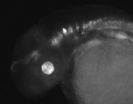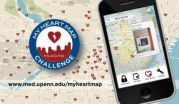(Press-News.org) Johns Hopkins researchers have succeeded in teaching computers how to identify commonalities in DNA sequences known to regulate gene activity, and to then use those commonalities to predict other regulatory regions throughout the genome. The tool is expected to help scientists better understand disease risk and cell development.
The work was reported in two recent papers in Genome Research, published online on July 3 and Sept. 27.
"Our goal is to understand how regulatory information is encrypted and to learn which sequence variations contribute to medical risks," says Andrew McCallion, Ph.D., associate professor of molecular and comparative pathobiology in the McKusick-Nathans Institute of Genetic Medicine at Hopkins. "We give data to a computer and 'teach it' to distinguish between data that has no biological value versus data that has this or that biological value. It then establishes a set of rules, which allows it to look at new sets of data and apply what it learned. We're basically sending our computers to school."
These state-of-the-art "machine learning" techniques were developed by Michael Beer, Ph.D., assistant professor of biomedical engineering at the Johns Hopkins School of Medicine, and by Ivan Ovcharenko, Ph.D., at the National Center for Biotechnology Information. The researchers began both studies by creating "training sets" for their computers to "learn" from. These training sets were lists of DNA sequences taken from regions of the genome, called enhancers, that are known to increase the activity of particular genes in particular cells.
For the first of their studies, McCallion's team created a training set of enhancer sequences specific to a particular region of the brain by compiling a list of 211 published sequences that had been shown, by various studies in mice and zebrafish, to be active in the development or function of that part of the brain.
For a second study, the team generated a training set through experiments of their own. They began with a purified population of mouse melanocytes, which are the skin cells that produce the pigment melanin that gives color to skin and absorbs harmful UV rays from the sun. The researchers used a technique called ChIP-seq (pronounced "chip seek") to collect and sequence all of the pieces of DNA that were bound in those cells by special enhancer-binding proteins, generating a list of about 2,500 presumed melanocyte enhancer sequences.
Once the researchers had these two training sets for their computers, one specific to the brain and another to melanocytes, the computers were able to distinguish the features of the training sequences from the features of all other sequences in the genome, and create rules that defined one set from the other. Applying those rules to the whole genome, the computers were able to discover thousands of probable brain or melanocyte enhancer sequences that fit the features of the training sets.
In the brain study, the computers identified 40,000 probable brain enhancer sequences; for melanocytes, 7,500. Randomly testing a subset of each batch of sequences, the scientists found that more than 85 percent of the predicted enhancer sequences enhanced gene activity in the brain or in melanocytes, as expected, verifying the predictive power of their approach.
The researchers say that, in addition to identifying specific DNA sequences that control the genetic activity of a particular organ or cell type, these studies contribute to our understanding of enhancers in general and have validated an experimental approach that can be applied to many other biological questions as well.
INFORMATION:
Authors on the brain paper include Grzegorz Burzynski, Xylena Reed, Zachary Stine, Takeshi Matsui and Andrew McCallion from The Johns Hopkins University, and Leila Taher and Ivan Ovcharenko from the National Center for Biotechnology Information.
Authors on the melanocyte paper include David Gorkin, Dongwon Lee, Xylena Reed, Christopher Fletez-Brant, Seneca Bessling, Michael Beer and Andrew McCallion from The Johns Hopkins University, and Stacie Loftus and William Pavan from the National Human Genome Research Institute.
This work was supported by grants from the National Institute of Neurological Disorders and Stroke (NS062972), the National Human Genome Research Institute's Intramural Research Program, the National Library of Medicine, the National Institute of General Medical Sciences (GM07814, GM071648), the National Science Foundation and the Searle Scholars Program.
On the Web:
Links to articles: Genome Research
Brain: http://www.genome.org/cgi/doi/10.1101/gr.139717.112
Melanocyte: http://www.genome.org/cgi/doi/10.1101/gr.139360.112
McCallion lab: http://www.hopkinsmedicine.org/geneticmedicine/People/Faculty/mccallion.html
Computers 'taught' to ID regulating gene sequences
2012-11-05
ELSE PRESS RELEASES FROM THIS DATE:
Superstorm animation
2012-11-05
A computer animation produced by University of Delaware researchers shows the explosive development of Hurricane Sandy, the superstorm and its unusual track. View the animation on the University's UDaily website at http://www.udel.edu/udaily/2013/nov/animation110212.html
Matt Shatley, computer research specialist in UD's College of Earth, Ocean, and Environment (CEOE), assembled the animation by digitally stitching together about 800 infrared images taken by GOES, the Geostationary Operational Environmental Satellite, which keeps a continuous eye on the continental United ...
Japanese family members less likely than others to give CPR for cardiac arrest
2012-11-05
Family members didn't give CPR for cardiac arrests as often as passers-by or friends in a Japanese study presented at the American Heart Association's Scientific Sessions 2012.
Cardiac arrest is the sudden loss of heart function, typically resulting from an abnormal heart rhythm that causes the heart to quiver erratically and stop pumping blood. According to the American Heart Association, effective bystander CPR provided immediately after sudden cardiac arrest can double or triple a victim's chance of survival.
In a review of 547,218 cardiac arrests occurring in 2005-09, ...
New device could allow your heartbeat to power pacemaker
2012-11-05
An experimental device converted energy from a beating heart to provide enough electricity to power a pacemaker, in a study presented at the American Heart Association's Scientific Sessions 2012.
The findings suggest that patients could power their pacemakers — eliminating the need for replacements when batteries are spent.
In a preliminary study, researchers tested an energy-harvesting device that uses piezoelectricity — electrical charge generated from motion. The approach is a promising technological solution for pacemakers, because they require only small amounts ...
Heart disease map of England highlights growing social inequality in older ages
2012-11-05
A study estimating the death rate from heart and circulatory disease in each electoral ward in England has found that despite considerable improvements since the 1980s, the difference between the wealthiest and poorest communities has widened for people over 65.
Mortality from heart and circulatory disease – the leading cause of death in the UK – declined in most places between 1982 and 2006, but for men and women aged 65 or older, the decline was smaller in the most deprived communities, resulting in a wider gap between rich and poor.
The authors, from Imperial College ...
Smallholder farmers need improved stake in Nile's development
2012-11-05
ADDIS ABABA (5 NOVEMBER 2012)—A new book finds that the Nile river, together with its associated tributaries and rainfall, could provide 11 countries—including a new country, South Sudan, and the drought-plagued countries of the Horn of Africa—with enough water to support a vibrant agriculture sector, but that the poor in the region who rely on the river for their food and incomes risk missing out on these benefits without effective and inclusive water management policies.
The Nile River Basin: Water, Agriculture, Governance and Livelihoods, published by the CGIAR Challenge ...
Cardiac bypass surgery superior to non-surgical procedure for adults with diabetes and heart disease
2012-11-05
Adults with diabetes and multi-vessel coronary heart disease who underwent cardiac bypass surgery had better overall heart-related outcomes than those who underwent an artery-opening procedure to improve blood flow to the heart muscle, according to the results from an international study. The research was supported by the National Heart, Lung, and Blood Institute (NHLBI), part of the National Institutes of Health.
The study compared the effectiveness of coronary artery bypass graft (CABG) surgery with a non-surgical procedure known as percutaneous coronary intervention ...
Penn Medicine contest maps 1,400 lifesaving AEDs via crowdsourcing contest fueled by smart phones
2012-11-05
LOS ANGELES – A crowdsourcing contest that sent hundreds of Philadelphians to locate and catalog the locations of AEDs throughout the nation's fifth largest city led to the identification of more than 1,400 automated external defibrillators in public places, according to a study from researchers from the Perelman School of Medicine at the University of Pennsylvania that will be presented today at the American Heart Association's Scientific Sessions 2012 (Abstract #17478). The efforts of these "citizen scientists" are expected to help provide crucial data to ensure quick ...
Families 'Play Nice' in Alpha Colony, Which Combines Competative and Cooperative Play
2012-11-05
DreamQuest Games has luanched its Kickstarter campaign for all new family-friendly game, Alpha Colony. What makes the game wholly unique is it's interesting balance of competitive and cooperative play. The goal of the game is to build the most prosperous prospector on a new and distant colony. But in Alpha Colony, it takes more than being the best to win. If the colony doesn't cooperate to thrive as a whole, everyone loses.
Alpha Colony's emphasis on cooperation makes it a game the whole family can enjoy. While creating an interesting dynamic for stronger players, it ...
Spectacular Pro/Am Holiday Dance Showcase coming to Rockport, Maine December 2, 2012
2012-11-05
Elegant Ballroom, Spicy Latin, Hip Hop, Contemporary, and steamy Belly Dance performed by individuals, couples, and choreographed groups all under the lights of Strom Auditorium (Strom Auditorium is located within Camden Hills Regional High School, Rt. 90, Rockport, Maine). Watch gorgeous costuming and stage settings from your comfortable seats in this beautiful state of the art facility. Dancers from all age groups will perform and there is something for every age group to see! Tickets just $12 in advance or $15 at the door. 207-594-0940 or http://www.swingnsway.com/showcase.htmlTickets ...
Compliance Consultant Jennifer Young of Kung Fu Family LLC Leads Major Seafood Safety Implementation in Hawaii and the Republic of Marshall Islands in November.
2012-11-05
Compliance Consultant Jennifer Young of Kung Fu Family LLC shifts focus from the Safe Quality Food (SQF) certification program implementation she is leading at Honolulu Hawaii-based Norpac Fisheries Export and travels to lead the same implementation at Marshall Islands Fishing Venture in Majuro. Ms. Young grew up in the major fishing markets of Honolulu and Louisiana. She has owned KFF LLC since 1995. The partnership with Norpac Fisheries Export began in 2009. She develops, leads, trains and implements over 40 key industry regulatory programs and requirements onsite, such ...


